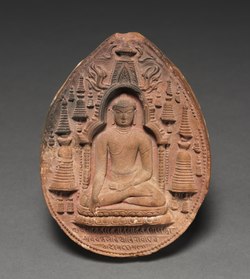Religion:Ye Dharma Hetu
In Buddhism, ye dharmā hetu, also referred to as the dependent origination dhāraṇī, is a dhāraṇī widely used in ancient times, and is often found carved on chaityas, images, or placed within chaityas.[1][2] It is used in Sanskrit as well as Pali. It is found in Mahavagga section of Vinaya Pitaka of the Pali Canon.
These words were used by the Arahat Assaji (Skt: Aśvajit) when asked about the teaching of the Buddha. On the spot Sariputta (Skt: Śāriputra) attained the first Path (Sotāpatti) and later told them to his friend Moggallāna (Skt: Maudgalyayana) who also attained. They then went to the Buddha, along with 500 of their disciples, and asked to become his disciples.[3]
Original text
Sanskrit
ये धर्मा हेतु-प्रभवा हेतुं तेषां तथागतो ह्यवदत्
तेषां च यो निरोध एवंवादी महाश्रमणः
In Roman transliteration this dhāraṇī is variously transliterated, depending on the language it was written in. In Sanskrit it appears as:
ye dharmā hetuprabhavā hetuṃ teṣāṃ tathāgato hyavadat,
teṣāṃ ca yo nirodha evaṃvādī mahāśramaṇaḥ
Pali
“𑀬𑁂 𑀥𑀫𑁆𑀫𑀸 𑀳𑁂𑀢𑀼𑀧𑁆𑀧𑀪𑀯𑀸, 𑀢𑁂𑀲𑀁 𑀳𑁂𑀢𑀼𑀁 𑀢𑀣𑀸𑀕𑀢𑁄 𑀆𑀳𑁇
𑀢𑁂𑀲𑀜𑁆𑀘 𑀬𑁄 𑀦𑀺𑀭𑁄𑀥𑁄, 𑀏𑀯𑀁𑀯𑀸𑀤𑀻 𑀫𑀳𑀸𑀲𑀫𑀡𑁄”𑀢𑀺𑁈
In Pali, its Roman transliteration appears as:
ye dhammā hetuppabhavā tesaṁ hetuṁ tathāgato āha,
tesaṃ ca yo nirodho evaṁvādī mahāsamaṇo.
Tibetan
ཆོས་གང་རྒྱུ་བྱུང་དེ་དག་གི། །རྒྱུ་དང་དེ་འགོག་གང་ཡིན་པའང་། །དེ་བཞིན་གཤེགས་པས་བཀའ་སྩལ་ཏེ། །དགེ་སློང་ཆེན་པོས་དེ་སྐད་གསུངས།། or ཆོས་རྣམས་ཐམས་ཅད་རྒྱུ་ལས་བྱུང་། །དེ་རྒྱུ་དེ་བཞིན་གཤེགས་པས་གསུངས། །རྒྱུ་ལ་འགོག་པ་གང་ཡིན་པ། །དགེ་སྦྱོང་ཆེན་པོས་འདི་སྐད་གསུངས།
In Tibetan, its Roman transliteration appears as:
chos gang rgyu byung de dag gi/ rgyu dang de 'gog gang yin pa'ng de bzhin gshegs pas bka' stsal te/ dge slong chen po de skad gsungs // chos rnams thams cad rgyu las byung/ de rgyu de bzhin gshegs pas gsungs/
rgyu la 'gog pa gang yin pa/ dge sbyong chen pos 'di skad gsungs //
Translation
Of those phenomena which arise from causes:
Those causes have been taught by the Tathāgata (Buddha),
And their cessation too - thus proclaims the Great Ascetic.[citation needed]
The Pāḷi commentaries take the first line as pointing to suffering (dukkha), the second to its cause (samudaya) and the third to its cessation (nirodha).
Copper plate in the Schøyen Collection
A copper place from the Gandhara region (probably Bamiyan), dated to about 5th century AD has a variation of the mantra. It appears to have some mistakes, for example it uses taṭhāgata instead of tathāgata. It is now in the Schøyen Collection. [4]
Miniature chaityas
The mantra has been widely used. It has been used at Sarnath, Tirhut, Kanari Copperplate, Tagoung, Sherghatti, near Gaya, Allahabad column, Sanchi etc.
On Buddha images
The mantra was often also carved below the images of the Buddha. A Buddhist screen (parikara) and accompanying Buddha image is now preserved at Museum of Fine Arts, Boston. While the objects were found in South India, the mantra is given in north Indian 8-9th century script, perhaps originating from the Pala region.[5]
Malaysia inscriptions
The Bukit Meriam inscription from Kedah includes two additional lines. The inscription is now in the Indian Museum, Calcutta. Other similar inscriptions were found in the Kedah region.[6]
ये धर्मा हेतु-प्रभवा हेतुं तेषां तथागतो ह्यवदत्
तेषां च यो निरोध एवं वादी महाश्रमण
अज्ञानाच्चीयते कर्म जन्मनः कर्म कारणम्
ज्ञानान्नचीयते कर्म कर्माभावान्न जायते
Ye dharmma hetuprabhavā hetun-teṣān-Tathāgata āha,
teṣān-ca yo nirodha evam-vādi Mahāśramaṇaḥ
Ajñānāc-cīyate karmma, janmanaḥ karmma kāraṇam
jñānān-na cīyate karmma, karmmābhāvān-na jāyate.
The additional lines can be translated as
Through ignorance karma is accumulated, the cause of birth is karma.
Through knowledge karma is not accumulated. Through absence of karma, one is not reborn.
Inscriptions in Pallava scripts found in Thailand
Ye dharma hetu is also found in Thailand including the stupa peak found in 1927 from Nakhon Pathom [7] along with a wall of Phra Pathom Chedi and a shrine in Phra Pathom chedi found in 1963,[8][9] a brick found in 1963 from Chorakhesamphan township, U Thong district of Suphanburi,[10] stone inscriptions found in 1964 [11][12] and the stone inscription found in 1980 from Srithep Archeological site.[13] All of them have been inscribed in Pallava scripts of Pali language dated 12th Buddhist century (the 7th Century in common era). Furthermore, there are Sanskrit version of ye dharma hetu inscribed in Pallava scripts in clay amulets found in 1989 from an archaeological site in Yarang district of Pattani dated to the 7th century CE.[14][15]
See also
- Āṭānāṭiya Sutta
- Awgatha, Burmese Buddhist Prayer
- Cetiya
- Dependent Origination
- Heart Sutra
- Jinapañjara
- Kāraṇḍavyūha Sūtra
- Maṅgala Sutta
- Mani stone
- Metta Sutta
- Nīlakaṇṭha Dhāraṇī
- Om mani padme hum
- Paritta
- Ratana Sutta
- Sacca-kiriyā, Declaration of Truth
- Shurangama Mantra
References
- ↑ "A New Document of Indian Painting Pratapaditya Pal". The Journal of the Royal Asiatic Society of Great Britain and Ireland (3/4): 103–111. Oct 1965.
- ↑ On the miniature chaityas, Lieut.-Col. Sykes, Journal of the Royal Asiatic Society, Volume 16, By Royal Asiatic Society of Great Britain and Ireland,, University Press, 1856
- ↑ Text and Translation of their story: http://www.ancient-buddhist-texts.net/Texts-and-Translations/Mahakhandhako/41-Sariputta-Moggallana.htm
- ↑ An Unusual ye dharmā Formula, in TRACES OF GANDHĀRAN BUDDHISM An Exhibition of Ancient Buddhist Manuscripts in the Schøyen Collection, TRACES OF GANDHĀRAN BUDDHISM An Exhibition of Ancient Buddhist Manuscripts in the Schøyen Collection, Hermes Publishing, 2010, p. 86
- ↑ Jan Fontein, A Buddhist Altarpiece from South India, MFA Bulletin, Vol. 78 (1980), pp. 4-21, Museum of Fine Arts, Boston
- ↑ The Malay Peninsula: Crossroads of the Maritime Silk-Road (100 Bc-1300 Ad), by Michel Jacq-Hergoualc’h, BRILL, 2002. p. 213
- ↑ "ฐานข้อมูลจารึกในประเทศไทย | จารึกเยธมฺมาฯ ๒ บนสถูปศิลา". https://db.sac.or.th/inscriptions/inscribe/detail/76.
- ↑ "ฐานข้อมูลจารึกในประเทศไทย | จารึกเยธมฺมาฯ ๑ (ระเบียงด้านขวาองค์พระปฐมเจดีย์)". https://db.sac.or.th/inscriptions/inscribe/detail/54.
- ↑ "ฐานข้อมูลจารึกในประเทศไทย | จารึกเยธมฺมาฯ ๓ (หน้าศาลเจ้าฯ)". https://db.sac.or.th/inscriptions/inscribe/detail/88.
- ↑ "ฐานข้อมูลจารึกในประเทศไทย | จารึกเยธมฺมาฯ บนแผ่นอิฐ (สุพรรณบุรี)". https://db.sac.or.th/inscriptions/inscribe/detail/150.
- ↑ "ฐานข้อมูลจารึกในประเทศไทย | จารึกเยธมฺมาฯ ๔ (พระองค์ภาณุฯ ๑)". https://db.sac.or.th/inscriptions/inscribe/detail/90.
- ↑ "ฐานข้อมูลจารึกในประเทศไทย | จารึกเยธมฺมาฯ ๕ (พระองค์ภาณุฯ ๒)". https://db.sac.or.th/inscriptions/inscribe/detail/146.
- ↑ "ฐานข้อมูลจารึกในประเทศไทย | จารึกเยธมฺมาฯ เมืองศรีเทพ". https://db.sac.or.th/inscriptions/inscribe/detail/156.
- ↑ "ฐานข้อมูลจารึกในประเทศไทย | จารึกเยธมฺมาฯ บนพระสถูปพิมพ์ดินดิบเมืองยะรัง (แบบมีรูปสถูปองค์เดียว) แบบที่ ๑". https://db.sac.or.th/inscriptions/inscribe/detail/748.
- ↑ "ฐานข้อมูลจารึกในประเทศไทย | จารึกเยธมฺมาฯ บนพระสถูปพิมพ์ดินดิบเมืองยะรัง (แบบมีรูปสถูปองค์เดียว) แบบที่ ๒". https://db.sac.or.th/inscriptions/inscribe/detail/3203.
External links



